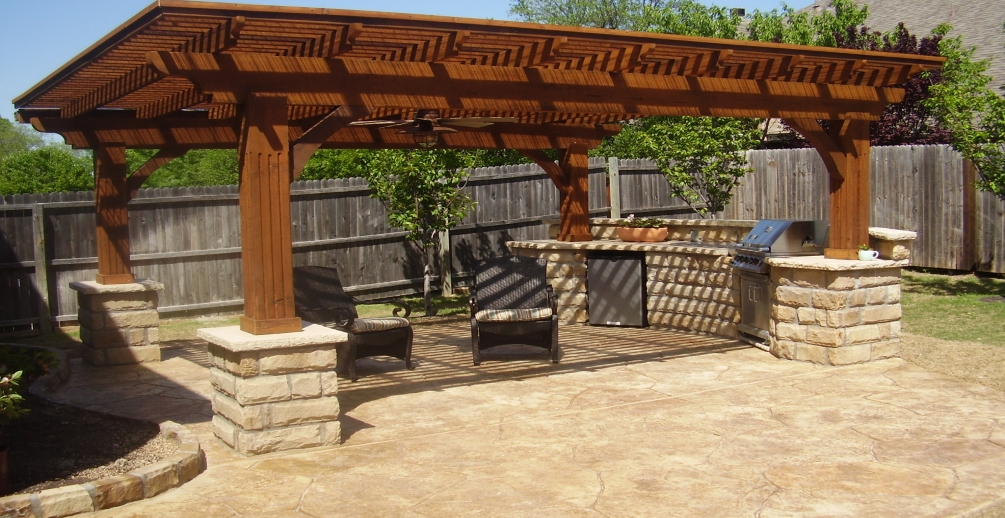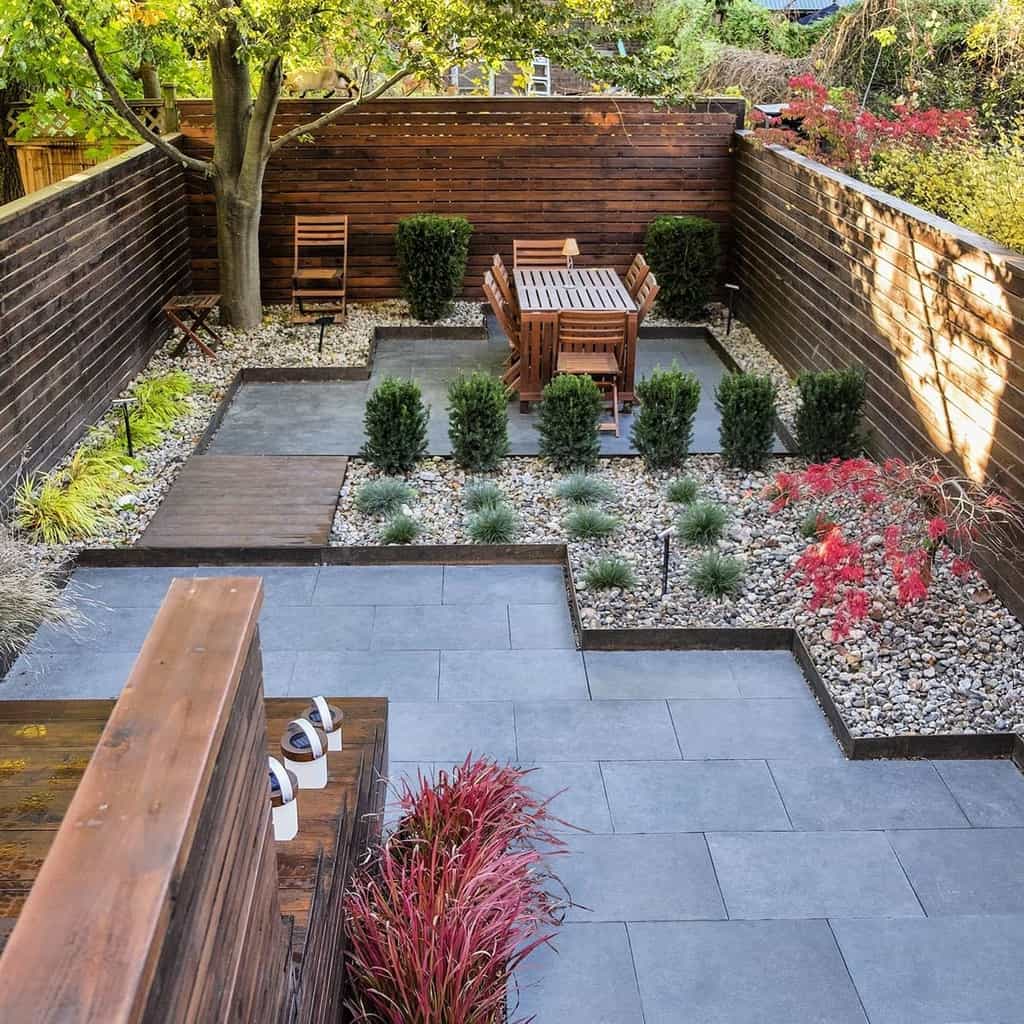Planning the Layout

Planning the layout of your hardscaping is crucial to creating a functional and aesthetically pleasing outdoor living space. It involves considering the flow of traffic, creating natural pathways, and strategically placing key features.
Designing a Functional and Aesthetically Pleasing Layout
The layout should cater to your desired activities and create a harmonious flow. A well-designed layout seamlessly integrates the hardscaping elements with the existing landscape, maximizing space and creating distinct zones for various activities. For example, a designated area for dining could be placed near the kitchen, while a fire pit area could be positioned for evening gatherings.
Creating Natural Pathways
Natural pathways guide movement through the space, creating a sense of flow and connection. Consider incorporating winding paths that lead to different areas of the outdoor space. The pathways can be made of materials like pavers, gravel, or even stepping stones, complementing the overall design and adding a touch of whimsy.
Illustrating the Layout with a Simple Diagram
Imagine a rectangular backyard with a patio area positioned at the back, close to the house. A winding path of pavers leads from the patio to a fire pit area in the center of the yard. To the left of the fire pit, a small vegetable garden is neatly laid out with raised beds. On the right, a cozy seating area with a pergola is created using gravel and strategically placed boulders. This simple diagram demonstrates how different hardscaping elements can be strategically placed to create distinct zones for various activities while maintaining a natural flow throughout the space.
Selecting Hardscaping Materials

The heart of your outdoor living space lies in the materials you choose for your hardscaping. These materials will not only define the functionality and durability of your patio, walkways, and walls, but also contribute significantly to the overall aesthetic of your design.
Choosing the Right Materials for Patios, Walkways, and Walls
The selection of hardscaping materials is crucial, as it impacts the longevity, functionality, and aesthetic appeal of your outdoor space. Each material has its own set of advantages and disadvantages, making it important to carefully consider your needs and preferences.
Patios
Patios are the focal point of most outdoor living spaces, so choosing the right material is essential. Here are some popular options:
- Natural Stone: Natural stone, such as flagstone, slate, and granite, offers a timeless elegance and natural beauty. It's highly durable, resistant to weather and wear, and comes in a wide range of colors and textures. However, natural stone can be expensive and requires skilled installation to ensure proper drainage and stability.
- Concrete: Concrete is a cost-effective and versatile option for patios. It can be poured into various shapes and sizes, and can be stained or stamped to mimic the look of other materials. Concrete is durable and low-maintenance, but it can crack over time if not properly reinforced.
- Pavers: Pavers, made from concrete, brick, or natural stone, offer a modular approach to patio construction. They are easy to install and can be arranged in various patterns. Pavers allow for drainage and can be easily replaced if damaged. However, pavers can be more expensive than poured concrete.
- Composite Materials: Composite materials, such as recycled plastic and wood fibers, offer a sustainable and low-maintenance option for patios. They are often resistant to moisture, insects, and rot, and come in a variety of colors and textures. However, composite materials can be more expensive than traditional materials.
Walkways
Walkways should be both aesthetically pleasing and safe. Consider these options:
- Natural Stone: Natural stone is an excellent choice for walkways, providing a durable and natural look. Flagstone, slate, and bluestone are popular options. Natural stone requires proper installation to ensure stability and prevent tripping hazards.
- Concrete: Concrete is a practical and affordable option for walkways. It can be poured in place or precast into pavers. Concrete is durable and low-maintenance, but it can crack over time if not properly reinforced.
- Pavers: Pavers are a versatile choice for walkways, offering a variety of materials, colors, and patterns. Brick pavers are a classic choice, while concrete pavers are more affordable. Pavers allow for drainage and can be easily replaced if damaged.
- Gravel: Gravel is a budget-friendly option for walkways, providing a natural and low-maintenance look. It's important to choose a gravel size that's appropriate for the walkway's use and to ensure proper drainage.
Walls
Hardscaped walls can add structure, privacy, and visual interest to your outdoor space. Consider these options:
- Natural Stone: Natural stone walls are a classic choice, offering a durable and elegant look. They are resistant to weather and wear, and come in a variety of colors and textures. Natural stone walls require skilled installation and can be expensive.
- Concrete: Concrete walls are a cost-effective and versatile option. They can be poured in place or precast into blocks. Concrete walls can be stained or painted to match your desired aesthetic. However, concrete walls can crack over time if not properly reinforced.
- Brick: Brick walls offer a timeless and classic look. They are durable and resistant to weather and wear. Brick walls require skilled installation and can be expensive. However, they can add significant value to your property.
- Composite Materials: Composite materials, such as vinyl or composite wood, offer a low-maintenance and durable option for walls. They are resistant to moisture, insects, and rot, and come in a variety of colors and textures. However, composite walls can be more expensive than traditional materials.
Material Aesthetics, Creating a beautiful outdoor living space with hardscaping
Each hardscaping material contributes to the overall aesthetic of your outdoor living space in a unique way.
- Natural Stone: Natural stone evokes a sense of timeless elegance and natural beauty. Its irregular shapes and textures add a rustic charm to any space. The color variations of natural stone create a sense of depth and dimension. For example, a flagstone patio with a mix of grey and brown tones would complement a modern farmhouse style, while a slate walkway with dark grey and black tones would create a sophisticated and elegant feel.
- Concrete: Concrete is a versatile material that can be used to create a variety of styles. It can be poured into smooth, sleek surfaces for a modern look, or stamped and stained to mimic the look of other materials, such as brick or stone. Concrete can also be used to create decorative features, such as fountains or fire pits. For example, a polished concrete patio with clean lines and a minimalist design would be ideal for a contemporary home, while a stamped concrete walkway with a cobblestone pattern would complement a traditional style.
- Pavers: Pavers offer a modular approach to hardscaping, allowing for a wide range of design possibilities. They can be arranged in various patterns, such as herringbone, basket weave, or running bond, to create unique and visually appealing surfaces. Pavers come in a variety of colors and materials, allowing you to customize your outdoor space to match your style. For example, a brick paver patio with a herringbone pattern would create a classic and elegant look, while a concrete paver walkway with a basket weave pattern would add a touch of modern sophistication.
- Composite Materials: Composite materials offer a sustainable and low-maintenance option for hardscaping. They are often resistant to moisture, insects, and rot, making them ideal for areas with high humidity or heavy foot traffic. Composite materials come in a variety of colors and textures, allowing you to create a unique and modern look. For example, a composite deck with a wood-grain finish would create a warm and inviting atmosphere, while a composite patio with a sleek, modern design would complement a contemporary home.
Enhancing Aesthetics: Creating A Beautiful Outdoor Living Space With Hardscaping

Creating a beautiful outdoor living space with hardscaping goes beyond functionality; it's about crafting a captivating ambiance that complements your home and lifestyle. By strategically integrating visual elements, you can transform your outdoor space into a haven of beauty and tranquility.
Mood Boards and Design Concepts
A mood board serves as a visual blueprint for your outdoor living space, showcasing the overall design concept and aesthetic. It can be created using a variety of materials, such as photographs, fabric swatches, paint chips, and magazine clippings.
A well-designed mood board helps to unify the design elements and create a cohesive look for your outdoor living space.
For example, a mood board for a modern outdoor living space might feature sleek, minimalist furniture, clean lines, geometric patterns, and a neutral color palette. In contrast, a mood board for a rustic outdoor living space might showcase natural materials, weathered wood, warm tones, and a touch of greenery.
Design Elements for Visual Appeal
Several design elements contribute to the visual appeal of an outdoor living space.
- Patios and Walkways: These elements define the space and create pathways for movement. Consider using materials like stone, brick, or concrete to create a visually appealing and durable surface.
- Retaining Walls: Retaining walls can be used to create level areas for seating or landscaping, and they can also be used to add visual interest to the space. Choose materials that complement the overall design, such as natural stone, brick, or concrete blocks.
- Fire Features: Fire pits, fireplaces, and outdoor fireplaces add warmth, ambiance, and a focal point to the space. Consider the size and style of the fire feature to ensure it complements the overall design.
- Water Features: Water features, such as fountains, ponds, or waterfalls, add a calming and serene element to the space. They can also help to create a sense of privacy and seclusion.
- Landscaping: Plants, flowers, trees, and shrubs can be used to add color, texture, and privacy to the space. Consider the size and growth habits of the plants to ensure they complement the overall design.
- Outdoor Lighting: Lighting is essential for creating a welcoming and inviting atmosphere in the evening. Consider using a variety of lighting techniques, such as path lighting, accent lighting, and overhead lighting, to create a visually appealing and functional space.
Color, Texture, and Lighting
The use of color, texture, and lighting is crucial in creating a cohesive aesthetic for your outdoor living space.
- Color: Choose a color palette that complements the surrounding architecture and landscaping. For example, a neutral color palette, such as beige, gray, and brown, can create a sense of calm and sophistication. Brighter colors, such as blue, green, and yellow, can add a touch of vibrancy and energy.
- Texture: Incorporate a variety of textures to add depth and interest to the space. For example, you can combine smooth stone with rough-hewn wood, or you can use a combination of different plant textures.
- Lighting: Lighting plays a vital role in setting the mood and creating a sense of ambiance. Use a combination of ambient, task, and accent lighting to create a warm and inviting atmosphere. Ambient lighting, such as string lights or lanterns, provides general illumination, while task lighting, such as spotlights or wall sconces, provides focused light for specific areas. Accent lighting, such as uplights or downlights, can be used to highlight specific features, such as plants or sculptures.
FAQ Explained
Creating a beautiful outdoor living space with hardscaping - What are some popular hardscaping materials?
Popular hardscaping materials include natural stone, concrete, pavers, and composite materials. Each offers unique benefits in terms of durability, aesthetics, and cost.
How do I choose the right plants for my outdoor space?
Consider your climate, soil conditions, and desired aesthetic when selecting plants. Local nurseries can provide expert advice on suitable species for your region.
What are some essential features for an outdoor living space?
Essential features include comfortable seating, dining areas, fire pits for warmth and ambiance, and lighting for evening enjoyment.
